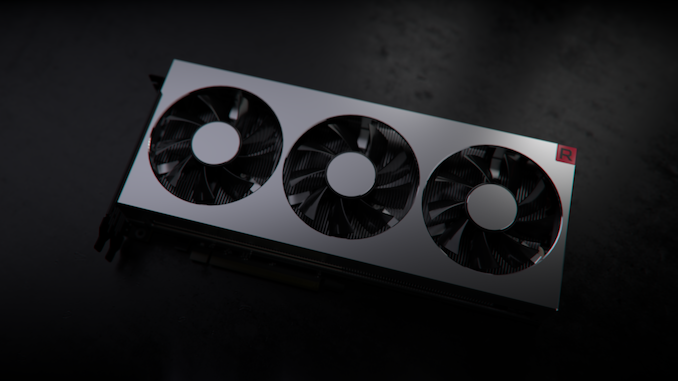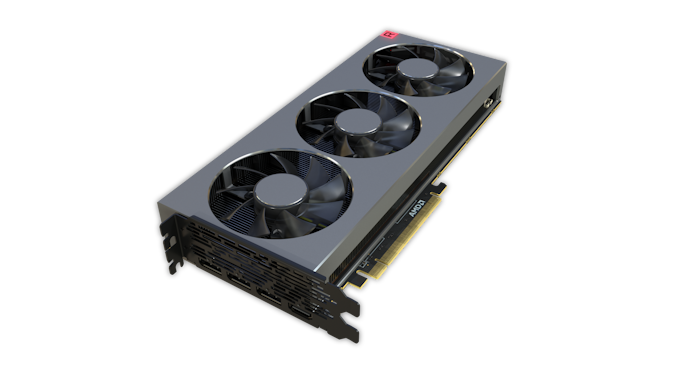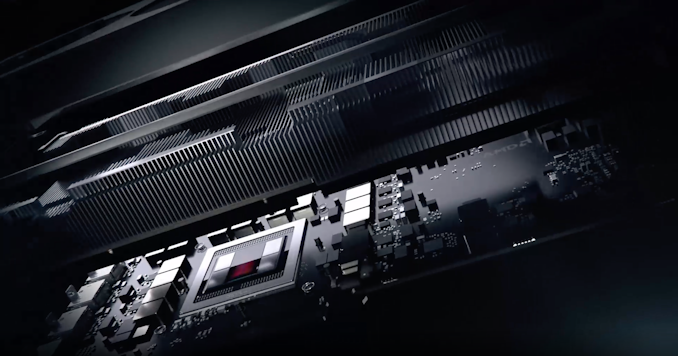The AMD Radeon VII Review: An Unexpected Shot At The High-End
by Nate Oh on February 7, 2019 9:00 AM ESTMeet The Radeon VII
First things first is the design and build, and for the AMD Radeon VII, we've already noticed the biggest change: an open air cooler. Keeping the sleek brushed metal look of the previous RX Vega 64 Limited Edition and Liquid variants, they've forgone the blower for a triple axial fan setup, the standard custom AIB configuration for high-end cards.
While NVIDIA's GeForce RTX series went this way with open-air dual-fan coolers, AMD is no stranger to changing things up themselves. Aside from the RX Vega 64 Liquid, the R9 Fury X's AIO CLC was also quite impressive for a reference design. But as we mentioned with the Founders Edition cards, moving away from blowers for open-air means adopting a cooling configuration that can no longer guarantee complete self-cooling. That is, cooling effectiveness won't be independent of chassis airflow, or lack thereof. This is usually an issue for large OEMs that configure machines assuming blower-style cards, but this is less the case for the highest-end cards, which for pre-builts tend to come from boutique system integrators.
The move to open-air does benefit higher TDP, and at 300W TBP the Radeon VII is indeed one for higher power consumption. While 5W more than the RX Vega 64, there's presumably more localized heat with two more HBM2 stacks, plus the fact that the same amount of power is being consumed but on a smaller die area. And at 300W TBP, this would mean that all power-savings from the smaller process were re-invested into performance. If higher clockspeeds are where the Radeon VII is bringing the majority of its speedup over RX Vega 64, then there would be little alternative to abandoning the blower.
Returning to the Radeon VII build, then, the card naturally has dual 8-pin PCIe connectors, but lacks the BIOS switch of the RX Vega cards that toggled a lower-power BIOS. And with the customary LEDs, the 'Radeon' on the side lights up, as does the 'R' cube in the corner.
In terms of display outputs, there are no surprises here with 3x DisplayPort and 1x HDMI.
A few teardowns of the card elsewhere revealed a vapor chamber configuration with a thermal pad for the TIM, rather than the usual paste. While lower-performing in terms of heat transfer, we know that the RX Vega cards ended up having molded and unmolded package variants, requiring specific instructions to manufacturers on the matter. So this might be a way to head off potential ASIC height difference issues.














289 Comments
View All Comments
eva02langley - Thursday, February 7, 2019 - link
I think you are the one in denial over this.This is a Radeon Instinct M150. This is a compute card that was never intended to be a gaming card. The biggest integration AMD had to do were drivers. Drivers will indeed be better in the next 3 months.
yasamoka - Thursday, February 7, 2019 - link
So please explain why AMD are designating this as a gaming card. I explained this in my previous post. Their lack of product differentiation is exhausting them and the apologetic acrobatics pulled by their die-hard fanboys is appallingly misleading. This is the same Vega architecture. Why isn't AMD releasing their cards with the drivers optimized beforehand? They have been doing this since the 7970. Remember that card getting beat by the GTX 680 just because they had unoptimized drivers? It took AMD almost a year to release drivers that thoroughly bested that series. CrossFire performance on these was also way ahead of SLi. It took them around another year to solve microstuttering. I had 2x 7970's back then. These delays need to stop, they're literally murdering AMD's product launches.Bp_968 - Thursday, February 7, 2019 - link
Nvidia is also guilty of the same thing. The entire Turing lineup is a die designed and R&Ded for the Enterprise customers. The "flagship features" they keep raving about for Turing are slapped together ways to use all the ASIC cores on the dies designed for AI and content creation.Its why when you compare a 1080 to a 2070, or a 1080ti to a 2080 (the same price bracket) you get almost zero rasterization improvements. Its a huge and expensive die reused from the enterprise department because no one else has anything competitive in the same space.
Nvidia is likely holding back their actual 12nm/7nm gamer design for 2020 out of concern for what Intel might have and possible concern over Navi. I also think Nvidia vastly underestimated how poorly the repackaged cards would sell. I expect Turing to be a very short generation with the next series being announced in late 2019 early 2020 (depending on what intel and AMD end up fielding).
Alistair - Thursday, February 7, 2019 - link
exactly!ToyzRUsKid - Friday, February 8, 2019 - link
The updated NVENC encoder chip may become a major selling point for the RTX cards for streamers/content creators. I'm actually disappointed Nvidia is not emphasizing this feature more. Once OBS Studio releases their new build that will further increase NVENC encoding efficiency it will create an even more compelling argument to switch to NVENC.I have been testing the new encoder and it's rivaling and beating medium preset x264 at 1080p60 using 8k bitrate. Single pc streamers will see steam quality improvements along with massive cpu resource savings. I'm of the opinion the dark horse selling point of these cards will be the new NVENC encoder. It appears the Turning generation is more of an advancement for content creators than the average gamer. Ray tracing is superfluous at this point for sure.
I'm ok with this. I still run a 1080Ti in my gaming rig and I'm comfortable waiting another generation. But the RTX 2070 in my streaming rig is delivering the best quality stream to date. That is comparing against x264 medium running on an i9 9900k@5GHz. This flies in the face of conventional wisdom and people with more credibility than me will need to help change the winds here. But this is my anecdotal experience.
rahvin - Friday, February 8, 2019 - link
If and I mean IF nvidia is holding back it's a purely financial move due to the huge overstock on GPU's caused by crypto currencies. Both AMD and nvidia massively underestimate how much demand crypto was creating. (IIRC AMD said during the earnings call now that crypto has dropped off that monthly GPU sales are less than half what they were) Supposedly there are more than 100K of nvidia cards (again the stuff I saw said that was somewhere between 3-6months normal gamer sales) sitting out there on store shelves rotting because of it, and it's so bad nvidia is having to take stock back from retailers that want the shelf space freed up.That's prime incentive to sit on the designs until the existing stock is used up. For both nvidia and AMD. Sure they might push out some high end high price product but they aren't doing anything in the middle of the market until that stock is cleared out.
Korguz - Thursday, February 7, 2019 - link
yasamoka...at the least.. this could force, what seems to be your saint nvida.. to drop the price of their cards.. as it stands before today.. ALL of their 20 series cards.. are out of the price range i would pay for a video card, or are pushing it/hard to justify the cost over my current 1060, as the 1070/80 were way out of my price range..
D. Lister - Thursday, February 7, 2019 - link
@KorguzThe RVII performs 5%-6% below the 2080 (as per this review) and yet is priced the same. How is that going to force Nvidia to cut prices?
Korguz - Friday, February 8, 2019 - link
well.. where i am at least.. the radeon 7 starts at 949 ( preorder ), only 2 cards listed, Asus and xfx. the gtx 2080 ( which the radeon 7 is aimed at ) starts at 1130, almost 200 more... IMO.. 200 is not worth the premium for a 5-6% faster card.. the top of the line 2080 is the GeForce RTX 2080 SEA HAWK X which is priced at $1275... for my cash... id be looking at the radeon 7.. and saving 200+ bucks to use some where else in my comp...TheinsanegamerN - Thursday, February 7, 2019 - link
The Instinct M150 is a VEGA class card, the architecture is incredibly similar to Vega 56/64. There are not massive gains to be made here.If there are, then AMD must be completely incompetent at driver management.